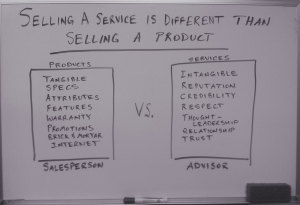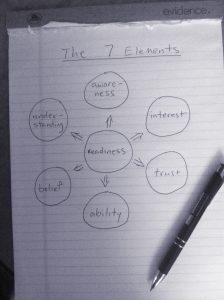A B2B client of mine that serves Fortune 500 companies recently asked me an intriguing question: “How do you sell professional services?” It was interesting because my client was already very successful, and I had never been asked the question so directly before. Like many good questions, I didn’t have a quick and easy response.
On the surface, my client’s question should have been straightforward for me to answer. It was a topic that I knew quite well through personal experience having worked for 25 years in professional services, high-tech, and software. However, as I sat down to prepare my answer to his question, I found myself wondering where I should start.
There is a lot of research and literature available for selling a product. This literature dates back nearly one-hundred years to Edward K. Strong’s 1925 book titled, The Psychology of Selling and Advertising. However, most of the literature on selling deals with consumer products. Comparatively, there is very little published research on selling B2B services or products. In my own research on the topic, I found a lot of valuable pieces to the puzzle, but my client and I didn’t find a comprehensive framework that we felt adequately told the whole story.
 I believe that selling a service is very different in nature than selling a consumer product. In product sales, the sales process is often attribute driven. Product salespeople typically focus on features and specifications. Think about how trucks, computers, and houses are sold. Now think about the last time you selected a web-developer, financial advisor, or personal trainer. What sorts of criteria did you think about in your selection? Was it features or specs? Probably not. In selling a service, personal relationships, trust, and credibility play key roles. In the illustration below, I highlight the key differences between selling products and services.
I believe that selling a service is very different in nature than selling a consumer product. In product sales, the sales process is often attribute driven. Product salespeople typically focus on features and specifications. Think about how trucks, computers, and houses are sold. Now think about the last time you selected a web-developer, financial advisor, or personal trainer. What sorts of criteria did you think about in your selection? Was it features or specs? Probably not. In selling a service, personal relationships, trust, and credibility play key roles. In the illustration below, I highlight the key differences between selling products and services.
It isn’t comprehensive enough to simply say, ‘build relationships, develop trust, and inspire credibility’. Herein began my month-long inquiry which led to what I call the 7 Elements – A Strategic Framework for Winning New Business in B2B. While the framework was developed with professional services in mind, I think it has applicability when thinking about all B2B sales.
This framework establishes key strategic pre-conditions in helping you think through your business development challenges. The framework is not tactical in the sense that it isn’t a ‘how to’ recipe. The tactics of business development will vary with each business and industry. However, the strategic pre-conditions that must be met are the same for every B2B business.
The framework also doesn’t replace having a solid marketing strategy. Rather, the two go hand in hand. A carefully crafted marketing strategy identifies: 1) what you do best, 2) who you serve, and 3) how you’re different. Working together, a solid marketing strategy along with the 7 Elements business development framework can help you succeed in growing your business.
The 7 Elements Framework begins with three key principles that I believe are core to business development in B2B companies:
Principle #1: People don’t like to be sold, but they like to buy if you can help solve their problems
Principle #2: People buy services from people they know, respect and trust, or based upon a recommendation from a trusted colleague
Principle #3: Selling a professional service is best understood from the customer’s point of view.
With these three principles in mind, here are the 7 Elements that my client and I developed over many cups of coffee based upon our experience in selling B2B products and services.
The 7 Elements
1. Build Awareness: I am familiar with your company
2. Develop Understanding: I understand what your company does, and how it is are unique
3. Create Interest: I sense that what your organization offers is credible, relevant and potentially of value to me
4. Inspire Belief: I believe that your unique offering is our optimal solution
5. Earn Trust: I trust that you are honest and dependable. I believe you have my best interests at heart, and I feel comfortable working with you
6. Determine Ability: I have the funds and organizational support needed to buy from you
7. Gauge Readiness: The timing is right and is now a priority for us to do business together
These 7 Elements represent the steps that a prospective client moves through in deciding to hire you and/or your company. Once you understand these elements from the customer’s point of view, it gives a strong sense of purpose to your advertising, marketing and business development efforts.
These steps often happen sequentially, but they don’t necessarily have to. A prospective customer can be aware of you and understand exactly what you do. They can believe in you and trust you. But, until there is a genuine need, organizational support, and funding, they aren’t interested or ready. Some services or B2B products are triggered by specific events that until they occur, you simply aren’t needed or vital to the client’s success.
In my experience, Elements 1 and 2 – awareness and understanding – are largely advertising and marketing related. Building awareness, and clearly articulating what you do best and how you’re different lend themselves well to your marketing toolbox – website, slide decks, videos, blogs, pr, networking events, etc.
Elements 3 and 4 – creating interest and belief – are divided between marketing and personal selling. It requires you to think carefully about the unique value you create. It requires a compelling solution to your prospective customer’s problems and needs. These two elements require careful thought about how you deliver value relative to your competitors and alternative solutions.
Element 5 – trust – is often the hardest and lengthiest milestone to achieve. While the first 4 elements can often be accomplished in a relatively short span of time, trust cannot be expedited. Trust requires the prospective client to a) believe you are honest, b) believe you are dependable, c) believe you have their best interests at heart, and d) feel comfortable working with you and your team. These human impressions take time to develop. Trust is often the most frustrating part of business development. Your prospective client has to arrive at your ‘trustworthiness’ on his or her own terms and timeline.
Elements 6 and 7 – ability and readiness – are largely out of your control. You have little influence over a prospective client’s funding situation and relative priorities. However, by being attuned to the importance of elements 6 and 7, you can understand where you are in the sales process and sensitive to the client’s organization environment. You can assist in the process by helping build an internal business case for your work and developing organizational support, but you can’t control when business crises shift funding priorities for your projects or the relative timing. An awareness of a client’s ability and readiness to hire you can bring patience and understanding to where you are in the business development process.
My client that originally got me thinking about ‘how to sell professional services’ has found a great deal of value in the 7 Elements framework. It has helped his team evaluate where each prospective customer is in the business development process.
If a sales effort gets bogged down, it has given my client’s team a common language to discuss and analyze the situation. Sometimes they need to back up and work on the client’s ‘understanding’ or ‘interest’. Other times its a ‘timing’ or ‘funding’ issue. Often times, it’s a ‘trust’ or ‘fit’ issue. And, as we have learned, trust cannot be expedited.
Conclusion
If you or your company are experiencing slow or declining sales, I believe the cause lies with one or more of the steps of the 7 Elements framework. The framework assists you in working through your unique business development challenges and growing your business. It goes hand-in-hand with a carefully crafted marketing strategy – where you define what you do best, who you serve, and how you are different. A smart marketing strategy working together with the 7 Elements framework can help you thoughtfully plan out your advertising, marketing, pr and business development efforts to increase your success in winning new business.

Leave A Comment